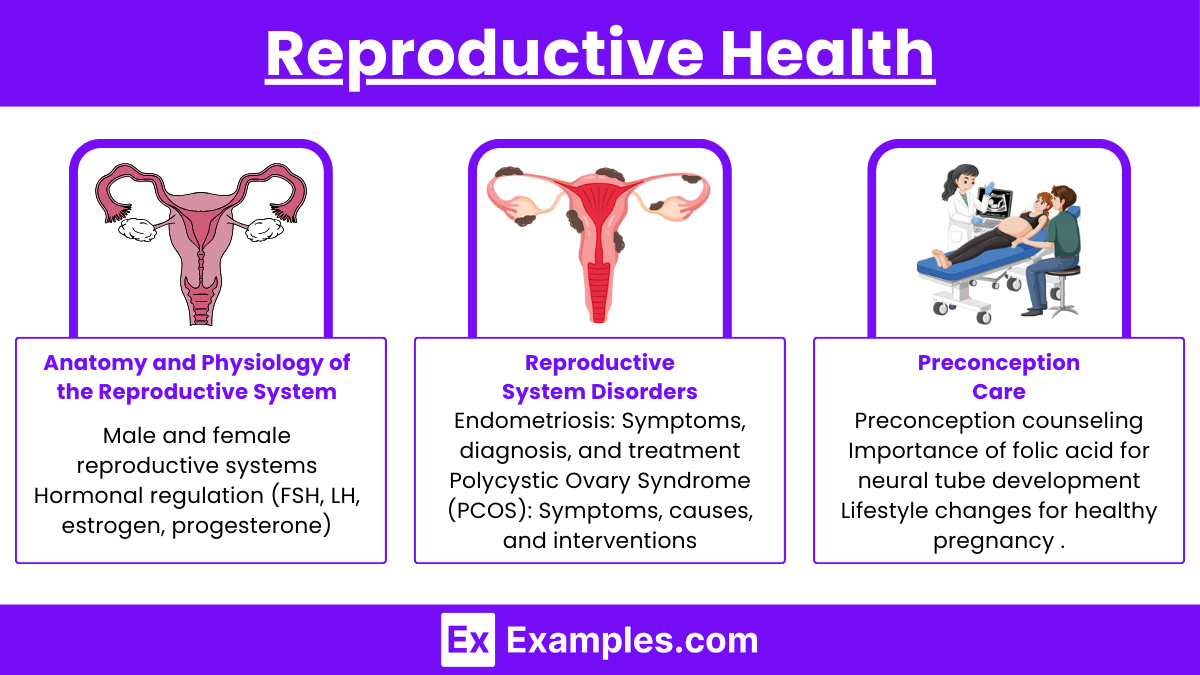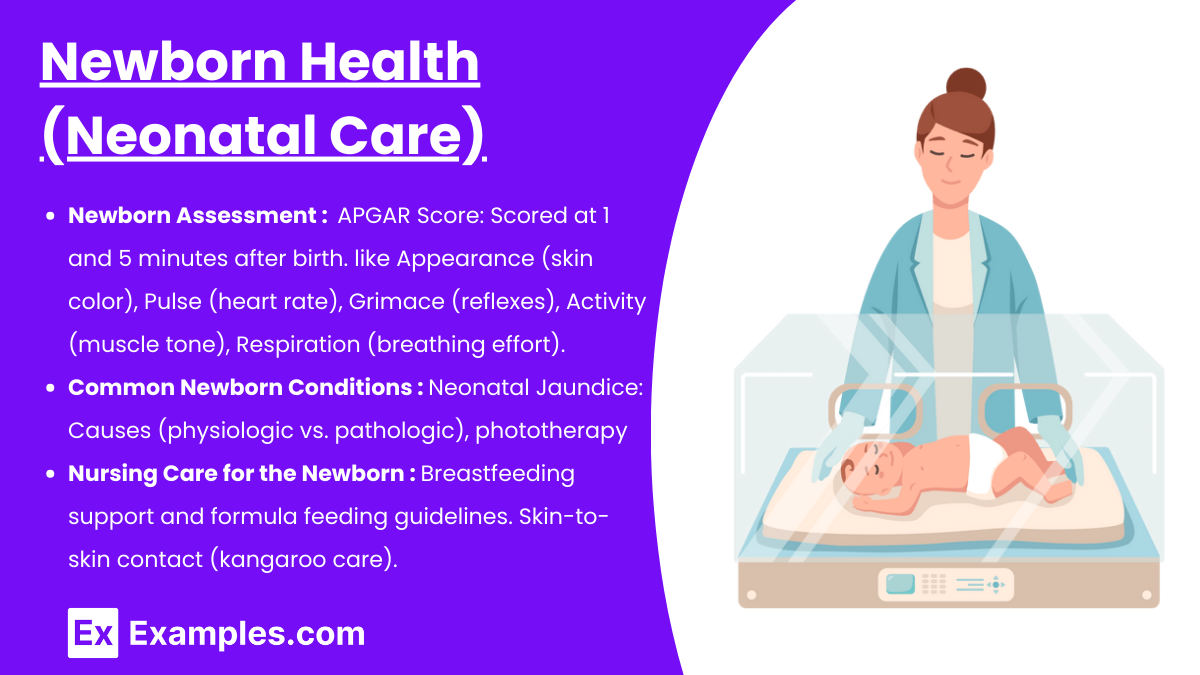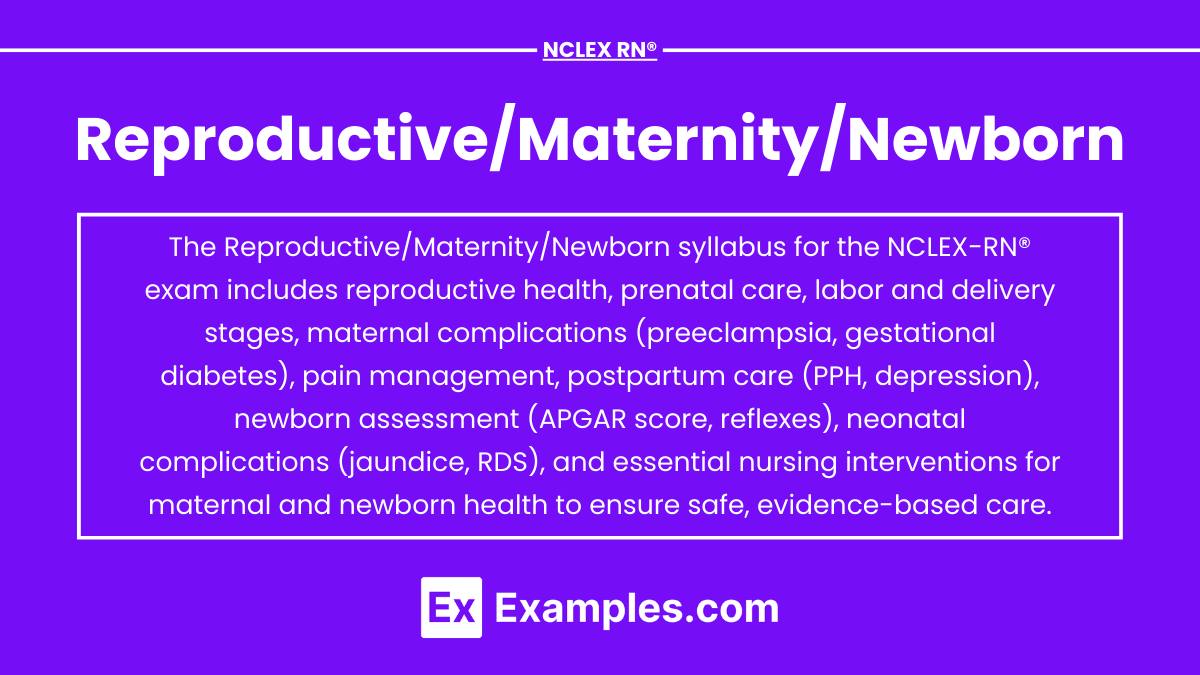The Reproductive, Maternity, and Newborn section of the NCLEX-RN® focuses on essential nursing knowledge required to care for pregnant individuals, mothers, and newborns. This area covers reproductive health, prenatal care, labor and delivery, postpartum care, and newborn assessments. Nurses must understand key concepts such as fetal development, maternal health complications, stages of labor, and newborn care protocols. Proficiency in this section ensures safe, evidence-based nursing interventions for mothers and infants, promoting positive health outcomes and increasing the chances of passing the NCLEX-RN® exam.
Learning Objectives
In studying "Maternal & Newborn Health: Reproductive, Maternity, and Newborn" for the NCLEX-RN® exam, you should learn to understand the stages of pregnancy, labor, delivery, and postpartum care. Analyze the nurse's role in providing care during antepartum, intrapartum, and postpartum periods. Evaluate essential concepts like fetal heart monitoring, labor stages, and neonatal assessments, including the APGAR score. Additionally, explore common complications such as preeclampsia, gestational diabetes, and postpartum hemorrhage. Apply your knowledge to assess maternal and newborn well-being, support breastfeeding, and ensure effective interventions for maternal-child health in practice scenarios and NCLEX-RN® practice questions.
Reproductive Health

Anatomy and Physiology of the Reproductive System
Male and female reproductive systems
Hormonal regulation (FSH, LH, estrogen, progesterone)
Menstrual cycle phases (follicular, ovulation, luteal, and menstruation)
Reproductive System Disorders
Endometriosis: Symptoms, diagnosis, and treatment
Polycystic Ovary Syndrome (PCOS): Symptoms, causes, and interventions
Infertility: Causes (male and female), diagnosis, and treatment options
Sexually Transmitted Infections (STIs): Types (chlamydia, gonorrhea, syphilis, etc.) and nursing care
Preconception Care
Preconception counseling
Importance of folic acid for neural tube development
Lifestyle changes for healthy pregnancy (smoking cessation, weight management)
Maternity Health

Prenatal Care (Antepartum)
Initial Assessment: Medical history, genetic counseling, physical examination
Routine Checkups: Blood pressure, weight, fetal heart rate (FHR) monitoring
Screening Tests: Ultrasound, amniocentesis, glucose tolerance test (GTT)
Complications During Pregnancy:
Gestational diabetes
Preeclampsia/eclampsia
Placenta previa
Abruptio placentae
Signs of Pregnancy: Presumptive, probable, and positive signs
Labor and Delivery (Intrapartum)
Signs of Labor: Lightening, bloody show, ruptured membranes (water breaks)
Stages of Labor:
Stage 1: Dilation and effacement of the cervix
Stage 2: Delivery of the baby
Stage 3: Delivery of the placenta
Stage 4: Recovery and postpartum care
Pain Management:
Non-pharmacological: Breathing techniques, hydrotherapy
Pharmacological: Epidural anesthesia, opioid analgesics
Nursing Care During Labor:
Continuous fetal heart rate (FHR) monitoring
Assessing for signs of fetal distress
Supportive care for the birthing person
Postpartum Care (Postpartum)
Physical Assessment: Fundal height, lochia, vital signs, pain
Complications: Postpartum hemorrhage (PPH), infection, deep vein thrombosis (DVT), postpartum depression
Breastfeeding and Lactation:
Proper latch techniques
Nursing interventions to support breastfeeding mothers
Newborn Health (Neonatal Care)

Newborn Assessment
APGAR Score: Scored at 1 and 5 minutes after birth
Appearance (skin color)
Pulse (heart rate)
Grimace (reflexes)
Activity (muscle tone)
Respiration (breathing effort)
Vital Signs: Heart rate (120-160 bpm), respiratory rate (30-60 bpm), temperature (36.5-37.5°C)
Normal Newborn Reflexes: Moro reflex, rooting, sucking, Babinski reflex
Physical Examination: Head-to-toe assessment, including weight, length, and head circumference
Common Newborn Conditions
Neonatal Jaundice: Causes (physiologic vs. pathologic), phototherapy
Respiratory Distress Syndrome (RDS): Causes, symptoms, and nursing care
Hypoglycemia in Newborns: Risk factors (infants of diabetic mothers), symptoms, and treatment
Infections in Newborns: Group B streptococcus (GBS) infection, sepsis, nursing interventions
Nursing Care for the Newborn
Skin-to-skin contact (kangaroo care)
Breastfeeding support and formula feeding guidelines
Maintaining a warm environment (use of radiant warmer)
Umbilical cord care (cleaning and preventing infection)
Examples
Example 1. Fetal Heart Rate (FHR) Monitoring
During labor, nurses must continuously monitor the fetal heart rate (FHR) to ensure the fetus's well-being. The NCLEX-RN® may present a scenario where a nurse observes a fetal heart rate deceleration on the monitor. The nurse must identify whether it is an early deceleration (caused by head compression), variable deceleration (caused by umbilical cord compression), or late deceleration (caused by placental insufficiency). For example, a question may ask, "What is the nurse's priority action when late decelerations are detected on the fetal heart rate monitor?" The correct response would be to reposition the client, provide oxygen, and notify the healthcare provider.
Example 2. Maternal Complications During Pregnancy (Preeclampsia)
The NCLEX-RN® often includes scenarios involving maternal complications, such as preeclampsia, a condition characterized by high blood pressure, proteinuria, and organ dysfunction during pregnancy. A sample question might describe a pregnant client at 32 weeks gestation with complaints of severe headache, blurred vision, and right upper quadrant abdominal pain. The nurse must recognize these as signs of preeclampsia and know that immediate intervention is required. The correct action would be to assess vital signs, initiate continuous fetal monitoring, and prepare for the possible administration of magnesium sulfate to prevent seizures.
Example 3. Neonatal Jaundice and Phototherapy
A common neonatal health scenario in the NCLEX-RN® involves jaundice in newborns. Questions may describe a 2-day-old newborn with yellow-tinged skin and a total serum bilirubin level of 15 mg/dL. The nurse must recognize that this level is elevated and that phototherapy is needed. The nurse should prioritize actions such as covering the newborn's eyes with protective patches, keeping the newborn warm, and encouraging frequent feedings to promote bilirubin excretion. A possible NCLEX-RN® question might ask, "Which nursing action is most appropriate to minimize complications for a newborn undergoing phototherapy?" The correct answer would include maintaining adequate hydration and monitoring the newborn’s temperature.
Example 4. Labor and Delivery (Stages of Labor)
The NCLEX-RN® frequently tests nurses' knowledge of the four stages of labor and appropriate nursing interventions for each stage. For instance, a question may describe a client in the active phase of Stage 1 of labor, experiencing contractions every 2-3 minutes lasting 60-90 seconds. The nurse is required to provide comfort measures (breathing techniques, pain relief) and monitor for signs of fetal distress. An NCLEX-RN® question could ask, "Which action should the nurse prioritize for a client in the second stage of labor with signs of crowning?" The correct answer would be to support the perineum and prepare for the delivery of the newborn.
Example 5. Postpartum Hemorrhage (PPH)
Postpartum hemorrhage (PPH) is a high-priority condition tested on the NCLEX-RN®. Nurses must know how to recognize, prevent, and manage excessive bleeding after delivery. A typical question may describe a client 2 hours postpartum with a boggy (soft) uterus, heavy vaginal bleeding, and blood clots. The nurse is expected to recognize this as uterine atony, a leading cause of PPH. The correct nursing actions include fundal massage, administration of oxytocin, and close monitoring of vital signs. A possible NCLEX-RN® question may ask, "Which action should the nurse take first for a client experiencing postpartum hemorrhage due to uterine atony?" The correct answer is to perform a fundal massage to stimulate uterine contractions.
Practice Questions
Question 1
A nurse is assessing a pregnant patient who is 32 weeks gestation. The patient reports severe headache, visual disturbances (blurred vision), and swelling in the hands and face. Which of the following actions should the nurse take first?
A. Instruct the patient to rest in a left lateral position.
B. Administer an antihypertensive medication as prescribed.
C. Check the patient's blood pressure and urine for protein.
D. Encourage the patient to drink more fluids to reduce swelling.
Answer: C. Check the patient's blood pressure and urine for protein.
Explanation:
The symptoms reported (severe headache, visual disturbances, and swelling of hands and face) are classic signs of preeclampsia, a potentially life-threatening condition during pregnancy. Early detection and management are critical to prevent complications like eclampsia or placental abruption. The nurse's first action is to assess the patient's blood pressure and check for proteinuria, as both are key diagnostic criteria for preeclampsia.
Option A (Incorrect): While the left lateral position improves blood flow to the placenta, it is not the priority action. Assessment must come before intervention.
Option B (Incorrect): Administering antihypertensive medication may be necessary, but it should only be done after the nurse has gathered objective assessment data.
Option D (Incorrect): Swelling due to preeclampsia is not relieved by drinking more fluids. This intervention is inappropriate for a patient with potential preeclampsia.
Question 2
A nurse is caring for a newborn 2 hours after delivery. The nurse notes that the infant’s hands and feet are bluish (acrocyanosis). What is the most appropriate action by the nurse?
A. Notify the healthcare provider immediately.
B. Place the newborn under a radiant warmer.
C. Perform a pulse oximetry reading on the newborn.
D. Document the finding as a normal assessment.
Answer: D. Document the finding as a normal assessment.
Explanation:
Acrocyanosis (bluish discoloration of the hands and feet) is normal in newborns during the first 24 to 48 hours of life as the circulatory system adapts to life outside the womb. This occurs due to the immaturity of peripheral circulation and is not a sign of oxygen deprivation or distress. Option D (Correct Answer): The nurse should document this as a normal finding. No immediate intervention is needed for acrocyanosis in the first few hours after birth.
Option A (Incorrect): This finding does not warrant a call to the healthcare provider, as it is a normal physiological response in the newborn period.
Option B (Incorrect): While maintaining newborn warmth is essential, placing the baby under a radiant warmer is unnecessary unless the baby’s core temperature is low.
Option C (Incorrect): Routine pulse oximetry is not required for acrocyanosis since it reflects normal newborn circulation. Oximetry would only be required if central cyanosis (bluish discoloration of the lips or face) was observed.
Question 3
A client in active labor reports severe lower back pain. The nurse recognizes that this pain is likely caused by which of the following fetal positions?
A. Left Occiput Anterior (LOA)
B. Right Occiput Posterior (ROP)
C. Left Occiput Posterior (LOP)
D. Right Occiput Anterior (ROA)
Answer: C. Left Occiput Posterior (LOP)
Explanation:
Severe back labor pain is typically associated with a fetus in the occiput posterior (OP) position. This is because the baby's head is pressing against the mother’s sacrum (lower back) during contractions, causing intense lower back discomfort. Option C (Correct Answer): The LOP position (Left Occiput Posterior) means the back of the baby's head is pressing against the mother's sacrum, leading to intense back pain, commonly referred to as "back labor."
Option B (Incorrect): The ROP position (Right Occiput Posterior) can also cause back labor pain due to pressure on the sacrum, but this position does not match the description provided.
Option A (Incorrect): The LOA position (Left Occiput Anterior) is one of the most favorable fetal positions for labor, as the baby’s face is toward the mother’s back, and back pain is usually minimal.
Option D (Incorrect): The ROA position (Right Occiput Anterior) is another optimal position for delivery, where the baby's face is directed toward the mother's back. This position does not usually result in back labor pain.


